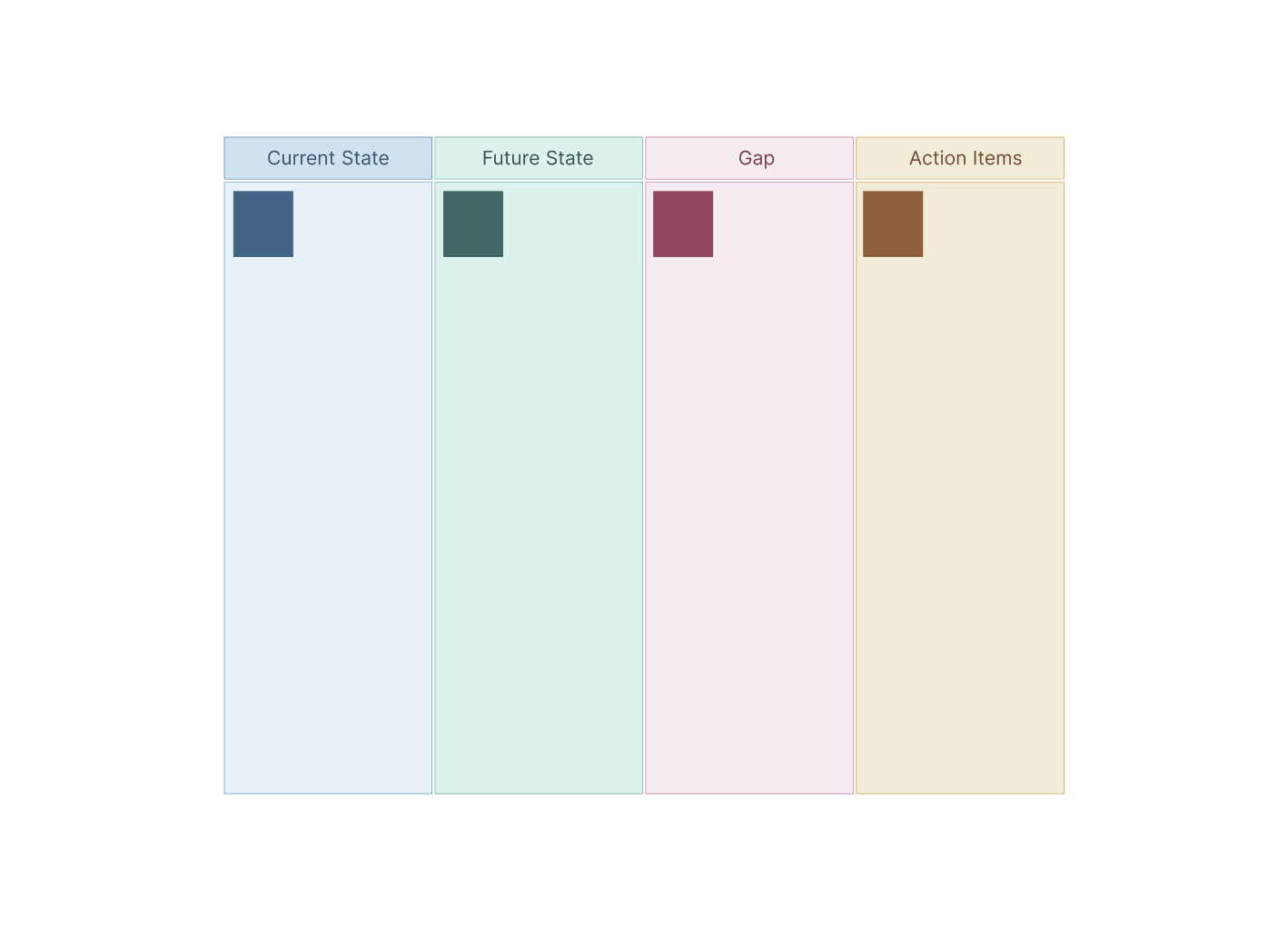A gap analysis is a simple but powerful way to find out what’s missing between where you are and where you want to be. It helps you compare your current performance with your goals so you can spot the gaps that need attention. Whether you’re trying to improve a process, reach a business target, or develop new skills, a gap analysis gives you a clear starting point and a roadmap for action. In this guide, we’ll walk you through how to conduct a gap analysis effectively—step by step.
How to Conduct a Gap Analysis in 8 Steps
Doing a gap analysis isn’t complicated—but it does take a bit of structure and clear thinking. Follow these simple gap analysis steps to figure out where you are, where you want to be, and how to bridge the gap in between.
Step 1. Start by defining your scope
Before diving in, decide what exactly you’re analyzing. This could be a business process, a team’s performance, a product’s success in the market, or even your organization’s overall strategy.
Ask yourself:
- What area needs improvement?
- Why is this important right now?
- Who needs to be involved?
This step helps you stay focused, choose the right stakeholders, and gather only the most relevant information.
Creately Tip: Use Creately’s AI Gap Analysis Template to auto-generate a workspace based on your scope. Just type in what you’re analyzing, and Creately AI will suggest structure and key elements to include.
Step 2. Set your goals – the desired future state
Think about where you want to go. This is your target or “future state.” Make it clear and measurable so you can easily track progress later on. A great way to do this is by using SMART goals—specific, measurable, achievable, relevant, and time-bound.
For example:
- “Increase customer satisfaction from 75% to 90% in the next 6 months.”
- “Reduce average delivery time from 5 days to 3 days by the end of the quarter.”
Step 3. Understand your current state
Now it’s time to take a close look at what’s happening right now. Gather both hard data and human insight.
You might:
- Pull reports on performance metrics, sales, costs, or usage rates.
- Talk to employees or customers through interviews or surveys.
- Review documents, policies, or past projects.
This gives you a realistic view of how far you are from your target.
Creately Tip: Use Creately’s infinite canvas to organize this information visually. Drop in notes, link data files, or embed documents right onto your workspace for easy reference.
Step 4. Identify the gaps
Once you have your current and desired states, compare them side by side. What’s missing? Where are you falling short?
This is where you calculate the “gap.” For example:
- If your current customer satisfaction is 75% and your goal is 90%, your gap is 15%.
- If you’re aiming for faster project turnaround, but most projects are late, the gap may be in process efficiency or team bandwidth.
Also consider the type of gap:
- Performance gap – You’re underperforming on something you should already be doing.
- Opportunity gap – You’re not doing something yet, but it could create value if you did.
Creately Tip: Create side-by-side columns to map out current vs desired performance. Highlight differences using shapes or icons. With Creately’s drag-and-drop interface, you can quickly spot and categorize the gaps.
Step 5. Dig into the root causes
To fix a gap, you need to understand what’s causing it. Don’t just treat symptoms—go deeper. Use tools like:
- The 5 Whys technique: Keep asking “why” until you reach the root cause.
- Fishbone diagrams (also called cause-and-effect diagrams): These help visualize all possible causes in categories like people, process, tools, and environment.
This step prevents you from solving the wrong problem.
Creately Tip: Use Creately’s diagram templates to map root causes visually. You can collaborate with your team in real time—drop comments, assign follow-up questions, and build the cause analysis together.
Step 6. Build your action plan
Now that you know what’s wrong and why, it’s time to fix it. Create an action plan with clear, practical steps to close the gap.
Your plan should include:
- What needs to be done
- Who is responsible
- What resources or support are needed
- A timeline for each task
- Metrics to track success
Keep it realistic—but make sure it stretches your team toward improvement.
Creately Tip: Use an action plan template to organize tasks visually. Convert each step into a task card, assign owners, set deadlines, and track completion—all within the same workspace.
Step 7. Put the plan into action and monitor progress
Launch your plan and keep an eye on how things are going. Don’t wait until the end to check results—track your KPIs regularly and make small adjustments as needed.
Using a visual tool like a dashboard, Gantt chart, or Kanban board can help keep everyone aligned and accountable.
Creately Tip: Manage execution visually using Kanban boards, Gantt timelines, or dashboards. Assign tasks to team members, track progress, and ensure accountability—all without switching tools.
Step: 8. Review, reflect, and repeat
Gap analysis isn’t a one-time activity. Once you’ve made progress, go back and review:
- Did you meet your goal?
- What worked well—and what didn’t?
- Are there any new gaps to tackle?
Use what you’ve learned to make future analysis even stronger. It’s a continuous cycle of improvement, not a one-off task.
Creately Tip: Keep everything in one place. Use your existing board to document reflections, make adjustments, and kick off your next round of analysis. Creately AI can help summarize changes and suggest next steps based on your updates.
Gap Analysis Example: Improving Customer Support Response Time
Scenario: A growing e-commerce company has been receiving complaints about slow customer support response times. The leadership team wants to improve this to boost customer satisfaction and reduce churn.
| Step | Details |
| 1. Scope | Email response time in customer support team |
| 2. Desired future state | Respond to all support emails within 4 hours, 90% of the time, by end of the next quarter |
| 3. Current state |
|
| 4. Identified gap |
|
| 5. Root causes |
|
| 6. Action plan |
|
| 7. Implementation & monitoring |
|
| 8. Review & results |
|
Tips for Gap Analysis and Best Practices
Here are some proven tips and best practices to help you get the most value from the gap analysis process:
Be clear about your objective: Start with a well-defined purpose. Whether you’re analyzing a process, a department, or an entire business function, knowing why you’re doing the analysis helps keep everything aligned.
Involve the right people: Engage stakeholders early—especially those who are closest to the issue. Their insights will help you capture both data and context, making the analysis more accurate.
Use visual models to map information: Visualizing current and desired states side by side helps teams spot gaps faster and align on priorities.
Focus on root causes—not just symptoms: Don’t jump into solutions too quickly. Use tools like the 5 Whys or fishbone diagrams to identify what’s actually causing the gap.
Quantify where possible: Use measurable metrics for both the current and future states. Numbers help you track progress and clearly define success.
Prioritize gaps that matter most: Not all gaps are equally important. Focus your efforts on those that will have the highest impact on performance or strategic goals.
Turn analysis into action: Gap analysis should lead to clear, actionable steps. Assign ownership, set timelines, and monitor follow-through.
Review regularly and iterate: Treat gap analysis as a continuous improvement tool. Revisit your findings, measure outcomes, and adjust as needed.
Ready to get started? Here are some gap analysis templates to get a head start.
Gap Analysis Template
Financial Gap Analysis
Fit Gap Analysis Template
System Fit Gap Analysis Template
Resources
Kim, S. and Ji, Y. (2018). Gap Analysis. [online] ResearchGate. Available at: https://www.researchgate.net/publication/327879112_Gap_Analysis.
Einstein, B. (2024). How Gap Analysis Can Drive Strategic Change in Your Company. [online] Business Insights Blog. Available at: https://online.hbs.edu/blog/post/gap-analysis.
Alordiah, C. (2023). MIND THE GAP: EXPLORING EFFECTIVE STRATEGIES FOR CONDUCTING GAP ANALYSIS IN EDUCATIONAL STUDIES. [online] 7(1), pp.239–252. Available at: https://www.researchgate.net/publication/374420184_MIND_THE_GAP_EXPLORING_EFFECTIVE_STRATEGIES_FOR_CONDUCTING_GAP_ANALYSIS_IN_EDUCATIONAL_STUDIES.
FAQs About How to Do a Gap Analysis
What should be done after a gap analysis?
What are the types of business gaps?
Common business gaps include:
- Performance gaps (underperformance against goals)
- Skills gaps (missing employee capabilities)
- Market gaps (unmet customer needs or opportunities)
- Compliance gaps (failing to meet regulations)
- Technology gaps (outdated or missing tools)
What are the key components of a gap analysis?
- Current state (where you are now)
- Desired future state (where you want to be)
- The gap (difference between the two)
- Root causes (why the gap exists)
- Action plan (steps to close the gap)
What are the types of gap analysis?
- Strategic gap analysis (aligning business strategy)
- Skills gap analysis (employee capabilities)
- Market gap analysis (opportunities in the market)
- Compliance gap analysis (regulatory requirements)
When to use a gap analysis?
Use it when you need to:
- Improve performance
- Plan strategic initiatives
- Identify training needs
- Adapt to market changes
- Ensure regulatory compliance







